This week’s box features five very different members of the brassica family, although they do all have elements – particularly flavour – in common; here’s some thoughts on what to do with them.
 Broccoli is a household staple and one of the mildest of the brassicas. Whilst it can be tempting to throw out the stem – and I admit I do often put it straight in the compost – if you peel any tough outer skin off it’s no different in flavour to the rest of the broccoli, and arguably easier to cook owing to its consistent texture. Steamed broccoli is delicious – especially when refried in garlic butter – but it also benefits from charring through roasting, grilling or cooking over coals. One of my favourite ways of preparing it is to remove any tough parts from the outside and then cut it into wedges lengthways. This gives an attractive “shard” of broccoli that’s perfect for these direct-heat methods of cooking.
Broccoli is a household staple and one of the mildest of the brassicas. Whilst it can be tempting to throw out the stem – and I admit I do often put it straight in the compost – if you peel any tough outer skin off it’s no different in flavour to the rest of the broccoli, and arguably easier to cook owing to its consistent texture. Steamed broccoli is delicious – especially when refried in garlic butter – but it also benefits from charring through roasting, grilling or cooking over coals. One of my favourite ways of preparing it is to remove any tough parts from the outside and then cut it into wedges lengthways. This gives an attractive “shard” of broccoli that’s perfect for these direct-heat methods of cooking.
Wombok and buk choy are both really two vegetables in one – the crisp, white stem is quite suited to eating raw or a longer cook, where the leaf wilts easily without the need to cook for a great length of time. If you’re using these for a stir-fry, it’s always best to add the stem parts to the wok earlier than the leaf to ensure that both parts cook to their ideal point. Wombok tends to be a bit milder in flavour than European style cabbages, probably because it also has a high water content – it makes a great coleslaw but it’s wise to eat it on the same day as mayonnaise-based dressings will mix with the water as it leeches out over time. Salt is great for removing water from cabbages – rub the shredded cabbage with salt for a few minutes and you’ll find quite a puddle at the bottom of your bowl (which is the first step in making sauerkraut). Steeping in salted boiling water is also a nice option to soften up the cabbage and draw out moisture before wringing out and dressing with oil based dressings – I quite like using sesame oil, soy sauce and something sour like citrus. Just like broccoli, wombok and buk choy are actually receptive to a good charring too – cut in half or quarters lengthways and grill until partly blackened before adding spicy-salty dressings.
 Mizuna steps up a notch from the previous three in terms of the characteristic mustardy flavour of the brassica family – I quite like to dress it lightly with a mustard, horseradish or wasabi-based dressing, although another nice option is to add some spiciness and sweetness to broaden out the flavour range. As most of the water in Mizuna tends to reside in the stems, the baby Mizuna leaves from York Town Organics won’t release much water into whatever you’re making. If you’re not a fan of the mustardy flavour, most of this can be removed by cooking – add it to a stirfry or quickly blanch it in salted water.
Mizuna steps up a notch from the previous three in terms of the characteristic mustardy flavour of the brassica family – I quite like to dress it lightly with a mustard, horseradish or wasabi-based dressing, although another nice option is to add some spiciness and sweetness to broaden out the flavour range. As most of the water in Mizuna tends to reside in the stems, the baby Mizuna leaves from York Town Organics won’t release much water into whatever you’re making. If you’re not a fan of the mustardy flavour, most of this can be removed by cooking – add it to a stirfry or quickly blanch it in salted water.
Turnips are probably the most hardcore of the brassica family, although the baby Japanese style turnips are much friendlier and are closer to a radish in flavour, although firmer in texture and more crunchy than crisp. Whilst I wouldn’t advocate eating large purple-skinned turnips raw, the baby turnips can be, although I’d suggest the optimum is something like al dente. Salt is again your friend with the bitterness of turnips – even the smaller ones can benefit from a blanch in salted water before being added to other dishes. They’re also rather good at soaking up salty and fermented Asian condiments like chilli-bean paste, miso, fermented tofu and others.

